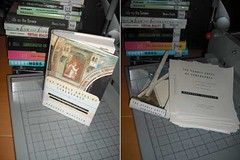
PREV ARTICLE
NEXT ARTICLE
FULL ISSUE
PREV FULL ISSUE
DIGITIZING THE PERSONAL LIBRARY
Tony Hine forwarded this article from the Wired Campus blog. WARNING - it will make bibliophiles cringe.
-Editor
Alexander Halavais, an associate professor of communications at Quinnipiac University, found a partial solution to his city dweller's no-space-for-books dilemma: Slice and scan. A digital file takes up a lot less room than a codex book does. In a post on his blog, A Thaumaturgical Compendium, Mr. Halavais described what he had done to some 800 of his books so far: "First I cut the boards off, and then slice the bindings. I have tried a table saw, but a cheap stack cutter works better. Then I feed [the pages] into my little page-fed scanner, OCR them (imperfectly) using Acrobat, and back them up to a small networked attached storage device." (See before-and-after pictures, above.) Many of the scanned books he also stores as image files. The process is slow and, yes, painful. "I'm over a thousand books in, and even now I get that—especially with hardcovers, for some reason—that gut feeling of 'Will I be judged by the book gods for doing this?'" Mr. Halavais said in an interview. "Destroying books is very difficult. If I could do this in a non-destructive way, I would." Google can draw on multitudes of technicians and high-end equipment for its huge book-scanning project. Mr. Halavais does it all himself and works with technology that suits a scholar's budget. He has a Fujitsu ScanSnap that "cost maybe $400," he said, pointing out that if you're handy you can build your own scanner out of scrap for a hundred bucks. The top candidates for translation into the digital sphere are books Mr. Halavais might want or need to consult for his research, which focuses on social computing. (As he explains on his blog, he examines "the ways new communication technologies are affecting politics, government, education, journalism, and business.") So his library contains books about technology and society and politics. "A lot of it is political science from the 1960s," Mr. Halavais said, as well as works such as Nicholas Negroponte's Being Digital (Vintage, 1995) and some of Bill Gates' oeuvre. Most are things that Mr. Halavais might want to cite now and then but is unlikely to reread all the way through. Mr. Halavais plans to keep about 500 of his 3,000 books in codex form. Fiction and unique or lovely books won't get the slice-and-scan treatment. Books heavy on photography or art don't scan well and are spared. So are books with sentimental value. "I still have my mom's copy of Das Kapital with her marginalia in it," Mr. Halavais said. "That's stuff that I probably won't scan, because I like to have it in the physical form." The Chronicle asked Mr. Halavais whether the scanned books still felt like a library. Without a physical presence, "no, they really don't," he said. The scanned material "feels like a resource, but it does not feel like a library in the same way." Mr. Halavais described his scanning project to an audience of publishers at the Association of American University Presses' conference in June as part of a talk on "The New University Press." He expected the audience to be dismayed. "They weren't really," he said. "In the publishing industry, remainders get destroyed." His students, however, are appalled when he describes what he does to his books. "I have students who are very digitally minded and are in a program in interactive communication, but they're aghast at the idea that I scan [books] and that I destroy them afterwards," he said. "Both of those are really disturbing to them." As for himself, "I will always have a bookcase," Mr. Halavais said. "But when I was a kid I thought when I grew up and became rich and famous, I would have a library room. That seems very unlikely now."
To read the complete article, see:
Digitizing the Personal Library
(chronicle.com/blogPost/Digitizing-the-Personal/27222/)
The Numismatic Bibliomania Society is a non-profit organization promoting numismatic literature. See our web site at coinbooks.org. To submit items for publication in The E-Sylum, write to the Editor at this address: whomren@gmail.com To subscribe go to: https://my.binhost.com/lists/listinfo/esylum All Rights Reserved. NBS Home Page Contact the NBS webmaster 
|
